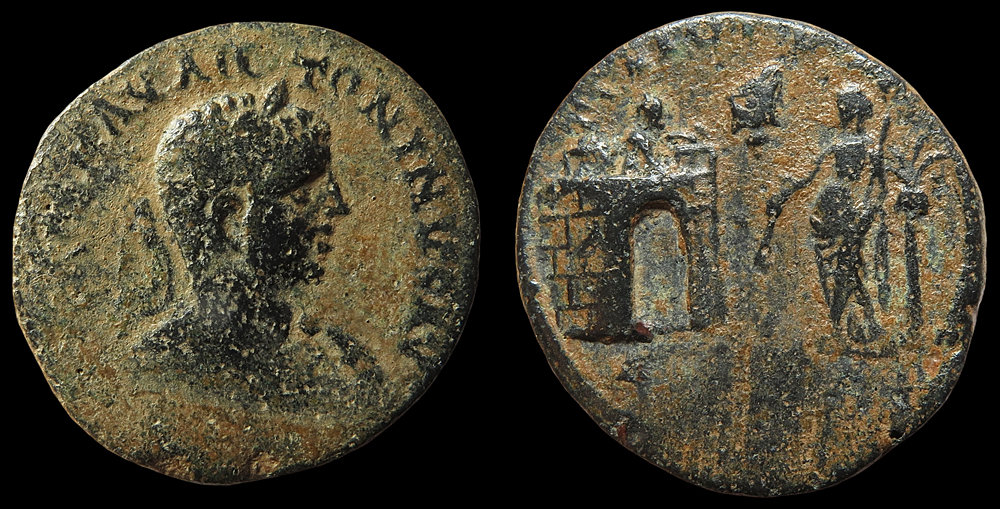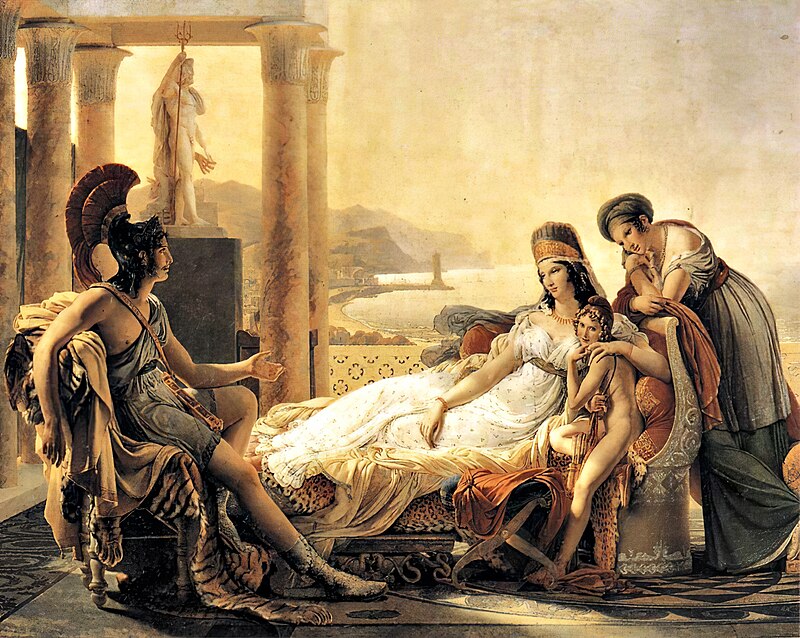The Building of Carthage

Elagabalus Æ29 of Tyre, Phoenicia. AD 218-222. Laureate, draped and cuirassed bust right / Dido building Carthage; she stands to front before the arched gate of the city, looking left, holding a rule and transverse sceptre; above the gate, a mason at work, [below, a man digging with pick]; murex shell in upper field, palm tree to right. Rouvier 2375; BMC 409; AUB 245; Price & Trell 748. 13.4g, 29mm, 6h. Very Fine. Rare.
What this coin lacks in quality it makes up for in history. Struck in Phoenicia under emperor Elagabalus, the reverse depicts Queen Dido overseeing the construction of Carthage. It’s a fascinating story of a legendary woman.
The abbreviated version:
Born to Tyrian King, the beautiful Dido (also known as Elissa) was to be co-heir with her younger brother Pygmalion. Upon the king’s death, however, Pygmalion was made sole ruler. Dido married her rich uncle Acerbas (also known as Sychaeus); Pygmalion murdered Acerbas in hopes of finding his reported hoard of buried treasure. Sensing trouble if she stayed, Dido devised a clever ruse to escape Tyre with the treasure.
She did escape, treasure in tow, and fled to coastal North Africa. There she persuaded King Iarbas to grant her some land. Her request was modest: only as much land as could be encompassed by an ox hide.
Dido cleverly cut the ox hide into fine strips and used that as a perimeter rope. It was long enough to surround and entire hill*. Local Berbers and nearby Phoenicians joined her. She enlisted their aid in construction; thus was born the magnificent and powerful city of Carthage.

J. M. W. Turner (1775-1851); Dido Building Carthage, 1815
This otherwise clever woman did something quite foolish at the end though. She killed herself in order to avoid marrying King Iarbas. History and legends say it was because she wanted to remain faithful to her first husband and because of this, she was deified and worshipped for honor her self-sacrifice.
A somewhat different and more poetic story of Queen Dido is told by Virgil in Aeneid. After his murder, Acerbas appeared to Dido in a dream and warned her to flee. He revealed where his gold was buried. Dido heeded the dream, took the treasure, and fled.
After establishing Carthage, notable visitors arrived… the last prince of Troy, Aeneas, along with various companions. The gods Juno and Venus conspired to make Dido and Aeneas fall in love.

Pierre-Narcisse Guérin (1774-1833, France); Aeneas Relating to Dido the Disasters of Troy, 1815.
King Iarbas wanted to marry Dido but she declined; she was in love with Aeneas. Angry that she preferred another, Iarbas banished Aeneas from the land.
Aeneas fled, leaving Dido heartbroken and scorned. Upon seeing his ship leaving she cursed him and promised endless hate between Carthage and Aeneas’s homeland, Troy. This legend lays the foundation for the impending Punic Wars.
As for this coin’s obverse— the very colorful emperor Elagabalus— I will save that story for the next coin, which I hope to post within the next few days.
*Commemorated in modern mathematics, “Dido’s Problem” deals with how to enclose the maximum area within a fixed boundary.
....
Post your coins of Carthage, Tyre, Elagabalus, or whatever else you feel fits the thread.
0
Comments
A reverse design which, I might add, is far more interesting than many you'll see on Roman or even Roman provincial coins of the era.
didn't know such a reverse existed on a coin, good stuff
WNC Coins, LLC
1987-C Hendersonville Road
Asheville, NC 28803
wnccoins.com
World Collection
British Collection
German States Collection
ZEUGITANA, Carthage
early 2nd century BCE
AE 15 shekel, 45 mm, 95 gm
Obv: wreathed head of Tanit left
Rev: horse standing right, left foreleg up; solar disk with uraei above
Ref: Alexandropoulos J (2000) Les monnaies de l'Afrique Antique, 103; Müller L (1861) Numismatique de L'Ancienne Afrique, 131; Luynes 3782; Jenkins GK and Lewis RB (1963) Carthaginian Gold and Electrum Coins. Royal Numismatic Society, London, pl.28 12
Graded Fine by NGC Ancients (strike 5/5, surfaces 2/5); not encapsulated (reason: size); certification number 3598288-002.
Extremely rare.
"not holdered: too big" come on, let's get those monster half pound AES Grave coins in slabs too
I agree it is much more interesting than the usual Roman reverses.
Amat Colligendo Focum
Top 10 • FOR SALE
For a while, Conders were king here. (And deserved their time in the sun.)
But I am quite happy to see ancients getting some exposure and discussion now.
There were times when I was a novice collector of Roman coins six or seven years ago that I felt rather lonely in that pursuit.
The forumancientcoins.com discussion boards are naturally the #1 place to go for discussing classical numismatics, but sometimes I feel a little intimidated there and like that the forums here cover a little bit of everything. Fits nicely with my eclectic tastes.
PHOENICIA, Tyre. Valerian I (CE 253-260)
Æ28.5 mm, 12.2 gm
Obv: IMP CP LIC VALERIANVS AVG; radiate, draped, and cuirassed bust right
Rev: COL TVRO METRO; the building of Carthage: Dido standing left, holding cubit ruler and scepter, surveying construction; mason above gate, worker with pick-axe digging before gate, murex shell to lower right
Ref: Rouvier 2501; BMC 470; cf Price & Trell 748
Emperor Valerian I had the misfortune to be captured by Shapur I. Depending on who you read, he was then:
--publicly humiliated by being used as Shapur's footstool, then flayed alive, stuffed, and mounted; or--allowed to live out his days in the comfort befitting his position, dying of old age at a much later date.
Since it's Halloween, let's go with version #1 todayWNC Coins, LLC
1987-C Hendersonville Road
Asheville, NC 28803
wnccoins.com
Amat Colligendo Focum
Top 10 • FOR SALE
<< <i>Yeah there were a lot of pretty terrible deaths for Emperors that were not nice. Who was the emperor murdered with his mother then dragged through the streets and thrown into the Tiber? Elagabalus and Julia Soaemias? >>
Yep, that was Elagabalus and his mom.
Amat Colligendo Focum
Top 10 • FOR SALE